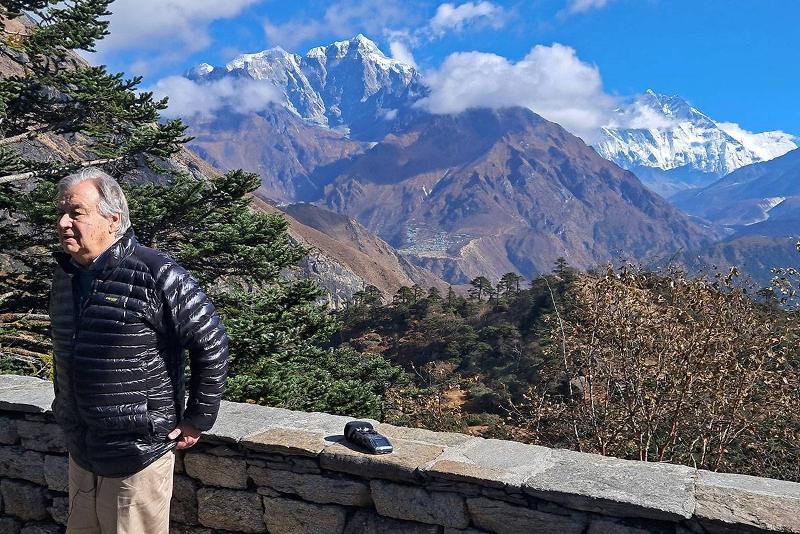In the breathtaking Himalayan regions, the world is witnessing the catastrophic consequences of climate change. Join me, John Green, as we delve into the alarming reality of melting glaciers and the urgent need to put an end to this madness. From the loss of ice in Nepal to the potential devastation of major rivers, the time to act is now.
The Alarming Rate of Glacial Melting
Explore the rapid loss of ice in the Himalayas and its dire consequences for the region and beyond.
The Himalayan glaciers, once majestic and resilient, are now succumbing to the relentless forces of climate change. Over the past three decades, Nepal alone has lost nearly a third of its ice, with glaciers melting 65 percent faster in the last decade compared to the previous one.
This alarming rate of glacial melting poses a significant threat to the region and the billions of people who rely on these icy reservoirs for freshwater. As the glaciers shrink, river flows diminish, jeopardizing the livelihoods and well-being of communities downstream.
But the consequences extend far beyond the immediate region. The Himalayan and Hindu Kush glaciers feed ten of the world's most vital river systems, including the Ganges, Indus, and Mekong. Billions of people depend on these rivers for sustenance, energy, and economic stability.
It is crucial to understand the devastating impact of glacial melting and the urgent need to address climate change to protect the future of these vulnerable regions and the interconnected ecosystems they support.
Threats to Water Security and Livelihoods
Examine the implications of melting glaciers on water security and the livelihoods of communities dependent on these resources.
The Himalayan glaciers act as natural reservoirs, supplying freshwater to over a billion people. However, as these glaciers melt, the availability of water becomes increasingly uncertain, posing a severe threat to water security.
Communities in the mountainous regions and the river valleys below heavily rely on these glaciers for agriculture, hydropower, and daily needs. The shrinking glaciers not only disrupt water availability but also contribute to the risk of devastating floods and landslides.
Furthermore, the loss of glacial meltwater affects the delicate balance of ecosystems, leading to biodiversity loss and ecological disruptions. The livelihoods of communities dependent on fishing, farming, and tourism are at stake, exacerbating poverty and inequality.
Addressing the threats to water security and the livelihoods of vulnerable communities requires immediate action to mitigate climate change and ensure sustainable water management practices.
The Global Impact: Beyond the Himalayas
Discover how the melting glaciers in the Himalayas have far-reaching consequences for the entire planet.
While the immediate impact of melting glaciers is felt in the Himalayan regions, the consequences reverberate globally. The reduced river flows from the Himalayas affect the water supply, agriculture, and energy production in South Asian and Southeast Asian countries.
Moreover, the melting glaciers contribute to rising sea levels, intensifying the risk of coastal flooding and erosion. Small island nations and coastal communities are particularly vulnerable to these climate-induced disasters.
Additionally, the release of stored carbon and other pollutants trapped in the ice further exacerbates global warming, creating a vicious cycle of climate change.
Recognizing the interconnectedness of our planet and the shared responsibility to combat climate change is crucial in addressing the global impact of melting glaciers and safeguarding the future of our planet.
Conclusion
The rapid melting of glaciers in the Himalayas is a clear and urgent signal of the devastating impact of climate change. The loss of ice not only threatens the water security and livelihoods of communities in the region but also has far-reaching consequences for the entire planet. It is imperative that we take immediate action to address climate change, reduce greenhouse gas emissions, and protect the fragile ecosystems that depend on these glaciers.
By stopping the madness of climate change, we can safeguard the future of the Himalayan regions, preserve vital freshwater resources, and mitigate the global impacts of melting glaciers. The time to act is now, for the sake of current and future generations.
FQA
What is causing the rapid melting of glaciers in the Himalayas?
The rapid melting of glaciers in the Himalayas is primarily caused by climate change. Rising temperatures due to greenhouse gas emissions lead to increased ice melt and reduced glacier mass.
How does the melting of glaciers affect water availability?
The melting of glaciers reduces water availability as the glaciers act as natural reservoirs. This poses a threat to water security for communities that rely on glacial meltwater for drinking water, agriculture, and hydropower.
What can be done to address the melting glaciers in the Himalayas?
Addressing the melting glaciers in the Himalayas requires global efforts to mitigate climate change. This includes reducing greenhouse gas emissions, transitioning to renewable energy sources, and implementing sustainable water management practices.

